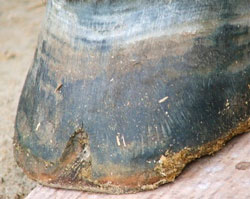Strictly speaking Seedy Toe refers to a chronic affliction of the front part of the foot where there is penetration by foreign material and damage to the tissues below the wall. This can occur with or without infection by anaerobes and creates severe damage to the tissues, requiring extensive stripping of the wall and long recovery and treatment periods.
However the term is often used to describe laminar separation with or without penetration of the area by foreign matter and/or infection (toe abscessation).
Causes of "seedy toe" can include chronic or previous bouts of laminitis (founder) with rotation of the pedal bone, white line disease, inadequate trimming, toecracks, as well as accidents and injuries which disrupt either the hoof wall or the hoof-sole junction (white line area) and which lead to a spreading or weakening of the area.
Prevention is therefore aimed at good hoof care. That is, regular trimming so that the toes don't become long, crack or cause excessive pressure on the lamina holding them to the foot to stretch them. Your farrier is your horse's friend in this regard.
Treatment depends on exactly what is going on in that particular case. Every case is an individual one and can be individual in different feet in the same horse.
The general principles of treatment involve opening up the "seedy" area to release pressure – both the pressure built up inside, and the pressure associated with walking around on dirt pushing it up into the little gap – then reducing the pressure to force dirt in by shortening the breakover point of the foot (think walking in hardsoled boots such as skiboots versus sneakers that bend in the sole). There may be a need to take Xrays of the foot to determine the extent of the damage, and sometimes to open up the front of the hoof over the seedy toe, or even to completely remove the whole section of hoof right up to the coronary band. This is obviously in a bad case, and the object of this note to you is to emphasise that prevention is much better than treatment, and early treatment is much easier on both the horse and your pocket!









